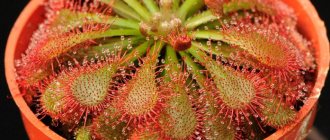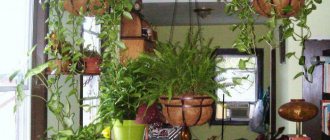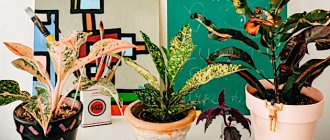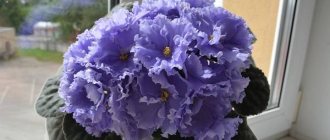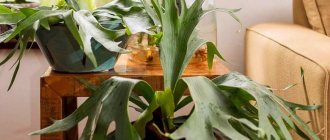The flora is many-sided and diverse. There are beautiful flowers with a terrible smell and ugly plants that exude wonderful aromas. In the magical kingdom of trees, bushes and flowers, there are many individuals that amaze the imagination with their growth, the ability to adapt to environmental conditions, and the ability to survive both in the jungle and in the desert.
There is a group of plants on the globe that belong to different families, but they have one thing in common - they are carnivorous. They can be found in any climate zone and on all continents except the Arctic. One of these plants is sundew.
Watering Sundews.
Watering the Sundew is carried out only in the pan (through the bottom). Water for irrigation should only be distilled (H20), or reverse osmosis (super purified without mineralization). Water from the tap, boiled, frozen, from a regular filter, cooler, etc. cannot be used under any circumstances - the plant will die because of this. Distilled water can be purchased on tap at pharmacies that prepare their own medications. This water can also be found in chemical and medical laboratories. Distilled water is sold in car dealerships and gas stations, but keep in mind that the quality of their water is somewhat worse than pharmacy water, so if possible, try to use pharmacy water. Sundew is a marsh plant and does not tolerate dry soil. Don’t be afraid to overwater the plant—it will happily survive it. Be careful not to dry out the plant; it will not tolerate drought. But there is an exception to this rule - this is the sundew "Paradoxa". She likes moderate watering. For watering, you need to use high trays that hold a large amount of water. In summer, watering should be intensive. The water level in the pan can reach two-thirds of the height of the pot (ground level in the flowerpot). In the cool season - autumn, winter and spring, watering should be slightly reduced, and the tray should be filled to one third of the pot (to one third of the ground level). Sundew does not like spraying from above. Sticky droplets that serve as its trap are produced by the plant itself and dew depends on the quality of lighting, water quality and watering. If the sundew is sprayed from above, its own dew will be washed away, and the plant will waste a lot of energy on its formation.
The most popular species of carnivorous plant in floriculture
Round-leaved sundew (Drosera rotundifolia) is found in marshy areas of the Northern Hemisphere. The leaves are small and rounded in the form of a blade, located on long petioles and covered with many cilia-hairs.
Drosera 'Roseana' is an Australian dwarf species (1-2 cm) that reproduces by viviparous gem buds - modified leaves produced to create a new sundew that is genetically identical to the mother plant.
Gems form inside a leaf rosette and germinate very quickly. The pink or greenish leaves of "Roseana" are densely covered with thin glands, making them look like fluffy balls.
Derby sundew (Drosera Derbyensis) is endemic to Western Australia. The leaf petioles, collected in a basal rosette, are numerous, narrow and slightly pubescent, and the leaf blade itself is tiny and round with pink hairs.
Cape sundew (Drosera capensis) is a species native to Africa. The height of narrow green-yellow or red-brown petioles with blade-shaped leaves is about 15 cm. It is distinguished by beautiful flowering with dark pink or pale pink flowers. This type of sundew has become widespread in home culture.
Drosera affinis is another tropical crop species that adapts to a wide range of temperatures thanks to its characteristic thin petioles and leaf blades reaching a height of 25 cm. In home cultivation it is represented by the Namibia variety. On a flower shoot up to 30 cm high, about 13 flowers are formed, which open alternately.
Alicia's sundew (D. aliciae) is a perennial tropical plant with a low basal rosette of 30 densely arranged oblong reddish or green leaves that reach 25-30 mm in length and 7 mm in width.
Leaf stems are absent. The lower leaves die off over time. The inflorescence of this species consists of approximately 2-12 purple flowers, which bloom alternately.
Royal sundew (D. regia) is native to South Africa. It got its name thanks to the long, up to 50 cm in height, spear-shaped leaves that form a crown. It forms several flower stalks at once, reaching a height of 60-90 cm. Lilac flowers are collected in loose inflorescences. The capture mechanism is very unusual - the leaves around the captured insects are wrapped as if in a knot!
Drosera nidiformis is an easily cultivated species from South Africa. D. nidiformis exhibits a reddish tint to the petioles and leaves when grown in bright light conditions. Does not tolerate cold temperatures. When capturing a prey, the leaf curls around it to ensure contact with as many digestive glands as possible.
There are also a large number of such magnificent hybrids and cultivars as Drosera falconeri, D. capensis x pululata, D. dielsiana x nidiformis, D. Pululata, hybrid sundew “Charles Darwin”, etc.
Soil for the predatory Sundew.
The substrate should be prepared on the basis of acidic high peat with an acidity of 3.0-4.0 pH. Before preparing the substrate, perlite must be soaked in distilled water for one and a half to two weeks, draining and replacing the water 3-4 times a week. The substrate is prepared in a ratio of 2:1 or 1:1 (acidic peat: perlite). Perlite allows water and air to pass through very well and also prevents mold from growing. If you do not have the opportunity to prepare such a substrate yourself, you can purchase it from us. You can also add dry sphagnum to the substrate. Sphagnum will help the substrate retain moisture longer and prevent drying out, and it also acts as an antiseptic, disinfecting the soil.
Features of raw material procurement
The sundew herb is harvested at the beginning of flowering. The plant is carefully pulled out of the soil; you can also cut the stem just under the ground. After removing the sundew, it must be thoroughly cleaned of any remaining dirt and moss.
Sundew is dried at a temperature of no more than 40 degrees. A well-ventilated room with a low temperature is ideal. The longer you dry a plant, the less beneficial properties will remain in it, so you should try to speed up the process as much as possible. Dried grass is suitable for use for two years.
Round-leafed sundew herb is harvested during the beginning of flowering
Flowerpot for Sundew.
To grow Sundew, you need to use only a plastic pot or glass flowerpot with holes in the bottom so that water can circulate easily. Planting plants in ceramic or clay pots is prohibited. The basis of the substrate for Sundew is high-moor acidic peat. When ceramics interact with such peat, they release harmful salts that have a very detrimental effect on the plant. Therefore, use only plastic or glass pots. The diameter of the plastic pot is 5-15 cm and depends on the size and variety of the plant. The diameter of a glass flowerpot for a florarium is limited only by the size of the plant and your imagination.
Description
The name of the plant “sundew” is due to its appearance. Small drops of dew collect on the antennae - it is thanks to them that the plant can quite successfully hunt insects. The plant is considered perennial.
The root network forms right at the base of the flower. The plant has sessile or petiolate leaves. They are completely covered with small hairs. They secrete a special sticky enzyme designed for hunting. Mucus is released directly upon touch.
- the length of the leaves can be completely different, from 10 mm to 50 cm - it all depends on where the sundew grows and what species it belongs to;
- the flowers have a pink or cream tint, they are collected in an inflorescence;
- a flower contains the same number of stamens and petals.
The pistil contains a large number of seeds that have a protein structure. The sticky substance, in addition to its viscosity, has a slight paralytic effect, which is indispensable when hunting. The stem is quite long, much longer than the leaves. This is required so that at the time of pollination, insects cannot fall into the trap.
Lighting for Sundew.
Sundew loves sunlight very much. Therefore, the flower pot should be placed on the south window, south balcony, on the south side of the house. It is very good for the sundew when it has a long sunny day. In the summer, when the sun becomes very intense, you can make dissected lighting for the plant, that is, use mesh material so that the sun's rays are dissected. To do this, you can use light shading nets, gauze, mosquito nets, and the like. With a lack of light, sundews may lose dew and stop forming new leaves. Dissected sun rays are acceptable, but not shadow. The more sunlight your plant gets, the better it will be for it. At a minimum, the plant should receive 4-5 hours of direct sunlight per day and the rest of the daylight hours should be diffused bright light. But there is a sundew - a special lover of very bright sunlight - Drosera "Paradoxa". When growing this type of sundew, you should not use any nets that cut through the sun's rays. The more sunlight falls on it, the more beautiful and healthy the plant will be. Carnivorous plants do not really like being rotated around an axis, so it is advisable to make some kind of mark on the pot regarding the cardinal direction and try to always adhere to this direction.
Artificial lighting is also suitable. The plant can be illuminated with very bright lamps, daylight or flora, with a power of ~36 W or more - full daylight - 12-16 hours with a lamp, 8 hours - at night, without a lamp. The distance of the lamp from the plant is 10-25 cm. The lamp for the plant should not glow!
The origin of the name “sundew” and the plant’s adaptation to the environment (with video)
The origin of the name “sundew” is explained by the fact that droplets of sticky mucus glisten on it, similar to dew or drops of honey. The sundew itself is colored red-green. The leaves of this small plant are covered with 25 cilia on the upper side of the leaf blade and along the edges where the longest ones are located.
The sundew's adaptation to its environment is unique. The upper end of the cilia is thickened. It is there that the gland is located, which secretes sticky mucus. Insects fly to the predator - the sundew, attracted by the shine of this droplet. But as soon as they touch the leaf, they stick. Soon, after 10 or 20 minutes, the eyelash to which the victim is stuck will bend towards the center of the leaf. All neighboring eyelashes will also bend.
Then the edge of the leaf blade will bend and the trap will slam shut. If there is a substance that does not contain protein on the eyelashes, for example, a drop of rain, they will not move. Enzymes secreted by the cilia break down protein (dewdew enzymes are similar to pepsin, the gastric juice of animals). After the plant has had lunch, the cilia straighten, become covered with “dew” again and attract new flies. Sometimes the digestive process can take several days. The South African royal sundew, a plant half a meter tall, can even digest snails and frogs.
Interestingly, the glue that insectivorous plants produce not only “grabs” unwary insects, but also acts like anesthesia. A dead insect from the edge of the leaf falls into its middle, the leaf shrinks, turning into something similar to a stomach. And when it opens a few days later, you can see the remains of the victim - just a chitinous cover.
The surface of the leaf becomes dry for a while, but when the plant “works up an appetite,” it again becomes covered with sticky dew and awaits a new victim.
Feeding the Sundew.
For any carnivorous plants, insects are fertilizers. In order for the Sundew to live and develop well, it does not need to eat too many insects, only 3-4 insects per year. If you want to feed the plant, then you need to remember that it cannot be overfed, because... it can become oversaturated with fertilizers from insects. You can feed it no more than once every 3-4 weeks - just one insect per leaf! If the insects are very small, for example, fruit flies or mosquitoes, then the sundew can eat more of them. Prey is usually digested from 2 days to a month, depending on the size and density of the insect. The plant from the insect sucks out the necessary nutrients, and the chitin remains. Under no circumstances should carnivorous plants be fed with anything other than insects. This is detrimental to the plant. Sundews live remarkably well for several months in a row without feeding at all. So in winter you don’t have to worry about feeding at all. And in spring, summer and autumn, the plant will independently find its prey. When purchasing a sundew, many are sure that it always wraps its leaves around the victim. But this is not entirely true. It takes a plant a lot of energy to roll a leaf. But the plant is not so stupid as to waste its energy at random. If the victim is very large and there are enough nutrients in it to replenish the energy expended on curling, and still reach the whole plant for good growth, then the sundew will curl the leaf around the insect. But if the insect is very small, then the sundew will only turn all its nearest antennae with dew towards the victim. Each sundew leaf can be folded up to 4 times. But there are sundews that do not fold their leaves at all, but only pull their dewy antennae towards the victim. These are, for example, Drosera Adelae, as well as filamentous sundews (Drosera Filiformis, “Hybrida”, etc.). Humidity and air temperature. Humidity is 45-70%, as for most indoor plants. Home conditions are acceptable. Air temperature in summer is 25-35 °C.
How does hunting happen?
The structure of sundew leaves is designed in such a way that sensitive receptors detect the slightest touch of organic objects that have nutritional value. There is no reaction to pieces, bark, crystals of earth and sand. As soon as a midge, mosquito, fly or any other insect, attracted by the fragrant smell, lands on the greenery, it immediately sticks to its surface without any chance of escape. The more they try to break out of the sticky captivity, the more sticky mucus the hairs produce. The leaf begins to curl around the paralyzed and no longer alive victim, starting the fermentation process. It can last from a few minutes to a week, depending on the type of predator plant. Once the prey is completely digested, the leaves unfurl again and are covered with shiny dewdrops in anticipation of new “food”.
Since in the wild the sundew prefers to grow on sandy and swampy soils, depleted of useful minerals, it obtains the lack of phosphorus, nitrogen, magnesium and other microelements through its hunting.
Wintering of the Sundew.
Most sundews are representatives of tropical or subtropical flora. They do not need a period of rest (wintering), but they definitely need additional lighting in the autumn-winter period. The additional illumination time is determined by a simple calculation: the length of daylight hours + so much artificial lighting time so that the total amount is 12 hours. For example, on the 20th of December we have 8 hours of daylight, which means we need to provide additional lighting for 4 hours. But there are sundews that naturally grow in temperate climates, that is, where there is a change of seasons, there is spring, warm summer, autumn and cool winter. In winter, these sundews rest, can partially or completely shed their leaves and form a wintering bud on the surface of the substrate, from which new beautiful dewy leaves will grow in the spring. Sundews of temperate climates include, for example: Drosera Filiformis Red, Drosera Filiformis, Drosera “Hybrida”, etc. Without this dormant period, the plant will be weak and may die. It is best for wintering to take place on the shortest sunny days. You can also navigate by the weather - with the arrival of cold weather, you can prepare for the winter. Until this moment, all these plants can live wonderfully outdoors all season long (outside in the yard, on the balcony, on the window). When the temperature drops to +7...+5, and even light frosts on the soil can occur at night, it means it’s time to winter. Usually this is November. We treat the plant with a fungicide to prevent mold from forming - Fitosporin M paste or Fundazol are very suitable. To do this, just spray the plant intensively with a spray bottle. A pot with a plant without a tray can be packed in a plastic bag, zip bag or plastic container; small holes must be left or made to allow some oxygen to flow in. About once every 2 weeks you need to check the soil for moisture and the absence of mold. The substrate in the pot should be slightly moist. Do not dry out under any circumstances. If there is not enough moisture, add a little water from above directly under the root. Plants that require a period of rest can be placed for wintering in a refrigerator, cellar, basement, on a glazed balcony, etc. The main condition for wintering is a low temperature ranging from +2 to +7 degrees. Higher temperatures are not suitable, since at high temperatures the plant’s vegetation does not slow down and it does not fully rest. The refrigerator is usually a stable +5, so this is the ideal temperature. Rosyanka does not need lighting at all during the wintering period. A baby and a teenager hibernate for 2.5-3 months, an adult Sundew winters for 3-4 months. Exit from wintering - as soon as the plants have spent the required period of rest, we take them out into the warmth, place them in a pan of water in bright light and continue to care for them as usual.
We present to you some types of Sundew with photos
Sundew Roundifolia
This is the most common type of Sundew. Most often it is found in peat bogs in temperate climate zones of Europe, America, and Asia. In Russia too. It is surprising that this predatory flower is popularly called affectionately - God's dew, Solar dew, Tsar's eyes, Rosichka. The flower has basal leaves with a rounded leaf plate, which is framed by hairs - red tentacles that secrete sticky mucus. The plant has a stem about 20 cm long. It blooms in mid-summer with white flowers. The fruits ripen in late summer in the form of single-lobed capsules. This species reproduces by seeds, which are collected in the fall and sown in greenhouses on the surface of moist peat soil. This is a winter-hardy species of Sundew. By winter, it forms special wintering buds, which go deeper into the thickness of sphagnum moss. When the sun begins to warm up and the snow melts, annual shoots appear from these buds.
This may be interesting: Nepenthes (Pitcher plant) - a predator in your home
The ground part of the round-leaved sundew is used for medicinal purposes. It contains ascorbic acid, tannins and dyes, organic acids. Decoctions of Sundew leaves are used for coughs as an expectorant (see above).
Sundew Cape
This type of Sundew is the most beautiful. It is most often grown at home. It grows all year round. An absolutely unpretentious plant. Can adapt to any living conditions. The Cape Sundew has a low stem, thin elongated leaves and numerous attractive white flowers. The plant reaches only 12 cm in height. But this does not prevent him from being just as dangerous a predator for insects as his tall relatives. The Cape Sundew has white hairs - tentacles with dew droplets at the ends, with the help of which the flower catches and absorbs food. The process of digesting prey usually takes several days.
Sundew Intermediate
This type of carnivorous plant is found most often in peat bogs in the United States, Cuba, Brazil, the Dominican Republic, and in many places in Europe. This is a low plant, five to eight cm in height. Its leaves are collected in a basal rosette and have an arched, back-lanceolate shape. The surface of the leaves is covered with numerous red hairs with glands, at the ends of which droplets of sticky mucus are secreted to hold and swallow insects. Flowering of Intermediate Sundew occurs in July – August. The flowers are white, very small. The plant does not have a winter dormancy period. It is considered the easiest to grow indoors.
English sundew
English sundew is poisonous
This species grows in the Hawaiian Islands, and is also common in Russia, the Caucasus, Central Asia, Belarus, and Ukraine. Prefers damp, sandy and sphagnum bogs. The height of the plant ranges from 7 to 25 cm. The leaves are thin on long petioles, reach a size of 10 cm, and are directed upward. Their shape is lanceolate. Blooms in mid-summer with white flowers. The fruit is a single-locular capsule with grayish-brown seeds. English Sundew is a poisonous representative of predatory plants and has medicinal properties. Use the entire above-ground part of a healthy plant. However, it is strictly prohibited to use blackened or dark brown grass for medicinal purposes due to its high toxicity.
All parts of English sundew contain ascorbic acid and other organic acids, naphthoquinones, and enzymes similar to pepsin. The plant has anti-inflammatory, antipyretic, bactericidal, diuretic, antispasmodic, expectorant and sedative effects.
Sundew Bisyllabic
This species of Sundew is native to New Zealand, Stewart Island, the Chattam Archipelago, and the southern coastal regions of Australia. Some varieties of this plant grow and bloom with white flowers all year round. Others go into a dormant state in winter. Sundew bisyllabic differs from others in its narrow, branching, forked leaves and impressive height - up to 60 cm.
Alicia's Sundew
Alicia's sundew hairs move prey to the center of the leaf
This subtropical sundew species came to us from South Africa. It has unusual leaves - in the shape of miniature plates, the surface of which is covered with numerous hairs - tentacles with droplets of mucus at the tips. These hairs are very sensitive. At the slightest touch they begin to move, bend and move their prey to the center of the sheet. Gradually, the leaf curls up around the insect and turns into something like a small stomach. When digestion is complete, the leaf unfolds and is again covered with drops of sweet, fragrant dew. Alicia's sundew blooms in racemes with small pink flowers.
Burman's sundew
Burman's sundew leaves wrap around prey in a few seconds
Grows in subtropical areas of Australia and Southeast Asia. The difference from other species is that it is the fastest carnivorous plant in the Sundew family in swallowing insects. Its leaves wrap around the prey in a few seconds, while in other Sundews this process takes minutes or even hours. Burman's Sundew has short stems and wedge-shaped leaves 10 cm long, forming a dense basal rosette. White flowers form tall racemes. There are up to three of them on one plant. The plant reproduces by seeds. Flowers on a long peduncle are self-pollinating. This species received its name after the scientist Johannes Burman, who first described it in his book “On the Flora of Ceylon” in 1737.
Sundew Filamentous
This rather large representative grows up to 50 cm in height. It has erect, linear, shimmering leaves. This species has two subspecies. The first subspecies includes the Threaded Sundew, Florida Red and Florida Giant. The second subspecies, Threaded Sundew variety Trace, grows in the northern Gulf Coast.
This may be interesting: Venus flytrap (Dionea) - home care
Sundew Otryskovaya
The sundew can reproduce with its mustache
Sundew grows at an altitude of 1200 meters above sea level on the cliffs and rocky shores of Australia. Small heart-shaped leaves on long petioles form a dense rosette with a diameter of about 6 cm. In the hot season, the leaves are pale green and yellowish in color. With the arrival of cold weather, they change their color to orange, red and purple. New specimens of the plant are formed on the peduncle where they come into contact with the ground and spread very quickly. In addition to traditional methods of reproduction, Sundew propagates, like our strawberries, by tendrils that form on the plant after it blooms. The speed of swallowing prey in this sundew species is average - folding a leaf around the victim takes about 20 minutes.
Sundew Glanduligera
The glanduligera sundew, with the help of the movement of its shoots, throws the insect into the center of the leaf, like a catapult
The glanduliger sundew has a unique mechanism that, like a catapult, throws the insect into the center of the leaf. This process is carried out with the help of the movement of the processes, which, due to changes in fluid pressure at the base of the processes, move at lightning speed (16 cm per second). Scientists biologists discovered this feature recently, and the process has not been fully studied. It is only known that such a process works only once. After which it dies, and a new one grows in its place.
Rosyanka Chereshkova
Sundew petiole has small trap leaves compared to other species
Grows in Australia and New Guinea. It has long narrow leaves forming a basal rosette from 5 to 30 cm in diameter and 15 cm in height. Compared to other sundew species, petiolate trap leaves are small. This is explained by the fact that it grows in areas with a hot climate, with temperatures up to 30 - 40 degrees. and lack of moisture. The flowers are common for Sundews, white.
Sundew Limonnikova
Schisandra sundew is also called jagged sundew or heart sundew.
It grows in Australia on the heavily shaded sandy banks of streams in the state of Queensland. A distinctive feature of this species is the notch at the top of the flat oval leaves. For this, she was nicknamed the jagged or heart-shaped Sundew. This is the most capricious species of Sundews to care for. This is explained by the fact that Schisandra Sundew has very thin, almost “papery” leaves, which are easily damaged and require high humidity. It also needs a lot of aeration. It will only grow in a dark place where the sun's rays do not reach.
Sundew Cistus
Sundew Cistus has the largest flowers
This species grows only in Africa, in the Northern and Southern Cape provinces of South Africa. This Sundew received its name due to the similarity of the inflorescences with flowers of the Cistus family. The plant is active during the colder months in moist, sandy substrates. In the extreme hot and dry conditions of South Africa (November-March), the plant survives by storing water and nutrients in the thick, fleshy and fibrous roots. The height of the stem reaches 40 cm; the leaves, 2 to 5 cm long, have no petioles and are located directly on the stems. The color of the leaves ranges from yellowish-green to red. Sundew Cistus has the largest flowers, more than 6 cm in diameter, which bloom in August-September.
This species is very variable. Almost every plant differs in its shape, height and leaf color. The color of the inflorescences can also be very different - from white, pink and orange, to crimson and red. In the vicinity of Darling, South Africa, you can find a rare, endangered form of Sundew Cistus, blooming bright red, with black veins down the center of the flower, making the flower very similar to a blooming poppy.
It can be assumed that the species of Cistus Sundew will be divided into subspecies and varieties in the near future.
Rosyanka Ordynskaya
Horde Sundew grows on sandy soils in Western Australia. A distinctive feature is wide petioles, densely covered with silvery tentacle hairs. The plant forms rosettes from 8 cm to 30 cm in diameter. The numerous leaves of Sundew Ordynskaya consist of a long, hairy petiole supporting an almost round leaf blade covered with tentacles. During the dry season, the leaves become smaller and dormant. Flowering occurs from December to April. The flowers are white and pink, about 1.5 cm in diameter. The plant requires a lot of light, the optimal growing temperature is +18...+30 °C. Does not withstand frost.
Sundew Bulbous
This is a low, broad-leaved, tuberous plant about 6 cm in diameter. The color of the leaves at the beginning of the growing season is pale green, and towards the end of the growing season it gradually becomes golden yellow and redder. Sundew bulbous grows in Western Australia. It has a typical rosette of leaves. It blooms from April to June with white flowers. The difference is the presence of yellow pollen and stems that form an annular space (crown) around the open tip of the ovary.
In this article we introduced you to the types and varieties. Read more about caring for Sundew at home.
Change of leaf at Rosyanka.
Sundews constantly change leaves. The old leaves die off from the bottom, and new ones grow from the center. When the leaves die, they turn black and dry out. It is not necessary to cut them off, but you can do this to make the plant look more aesthetically pleasing. It is important to know that you cannot tear off blackened leaves, because... You can damage the plant or tear it off from the base. Blackened leaves must be cut off, leaving 2-5 mm from the beginning of growth. The color of a healthy sundew leaf can range from completely green to completely red. This depends on the time of year, lighting, substrate composition and temperature conditions, in some cases on the Rosyanka variety. The temperature regime in this case is the fluctuations in day and night temperatures. The greater the temperature changes, the greater the likelihood of sundew coloring, if this is inherent in this variety.
Problems in care
The insectivorous sundew can develop root rot at home. The reason may be such errors in care as a constant excess of water in the soil, cold temperatures that increase the risk of developing the disease, and lack of light.
Symptoms of root rot: leaf blades are completely curled, hairs do not produce secretions, petioles fall off. To save your pet, you must immediately replant it in a new substrate and treat the roots with a fungicide.
Read on the topic: Diseases of indoor flowers
Secretion production may stop after replanting or if the leaf is touched frequently. It will form on new leaves.
Mature plants die back from time to time, but usually new shoots develop from stems or roots after a few weeks.
Ironically, carnivorous plants are attacked by pests, although very rarely. Aphids and thrips cause deformation of the ground part and stunting of growth.
You need to remove pests manually or use folk remedies. The use of insecticide is not recommended, since the chemicals cause the secretion to dry out and reduce the amount of its production.
Author: Yulia Zakrevskaya Updated: January 31, 2021
- Little ones
- Decorative foliage
- Exotic
Sundew pests.
It is very rare, but sometimes it happens that sundews are attacked by aphids. It is very small and white. To successfully combat this aphid, it is enough to treat the plant once with a spray bottle (spray) with some anti-aphid preparation purchased at a garden store. The main thing is that on the packaging of the drug, in the list of which insects it fights, aphids are also listed. “Aktara” is also effective against aphids. Sundew is constantly in a humid environment, so it is susceptible to disease from various types of pests and fungi. Means for treating plants against pests and diseases: - Aktara - an insecticide with enteric contact action. Very effective against small insects that have settled in the substrate and aphids. — Confidor maxi very successfully fights against aphids, which can sometimes settle on sundews, butterworts, etc. Yes, and with other insects this remedy is very effective. — Fitosporin M paste is a biofungicide for protecting plants from fungal and bacterial diseases. — Fundazol is a fungicide and disinfectant with a broad spectrum of action against a large number of fungal diseases.
If you grow Drosera in accordance with the above conditions, you will have strong, healthy plants that will delight you for many years. With proper care, Drosera lives 5-7 years and during this time reproduces many times.
Growing Sundews from Seeds
Plant seeds are very fine, like dust, and require special care when handling them.
Dilute the fungicide in distilled water in a proportion of 1 g per 1 l, respectively 0.1 g per 0.1 l. Shake well until dissolved. Place the substrate in the lower part of the mini-greenhouse. Spray with fungicide solution. Place the seeds on the surface of the substrate, do not bury them on top. Seeds must see light. Close the mini-greenhouse with a lid and place it in a tray with distilled water on a southern windowsill, or under a phytolamp (minimum 36 Watt) for 14-16 hours/day. They germinate at a temperature of 20-25 °C, with high air humidity and good lighting, in 3 - 4 weeks; germination can take up to several months. You only need to water into the tray. Plants are swampy, so it is necessary that there is always a little water in the pan, about 0.5-1.5 cm. After the seedlings have reached a size of 1-2 cm, they must be transplanted into separate pots. For transplantation, you can use tweezers and a toothpick.
Plant subspecies
To date, just over 150 subspecies of this predatory flower are known. The most famous subspecies:
- Round-leaved - grows in temperate swamps. Latin name: Drosera rotundifolia. The leaves are oval and grow on elongated petioles. They reach no more than 2 cm in diameter. They look like miniature plates. The upper part of the leaves has villi.
- Cape - the most beautiful of all subspecies. Latin name: Drosera capensis. Endowed with very short branches. The leaves are graceful and thin. They grow on elongated petioles. The color of the leaves is emerald-amber or burgundy-brown. The plant's eyelashes are burgundy. Once the insect is trapped, the leaves of the plant are curled into a small roll. The plant is endowed with beautiful flowers.
- Intermediate - the rarest subspecies.
- Longifolia - has narrow, elongated leaves. Grows in swamps and overgrown rivers. Sometimes it is called "English".
Read more about the varieties of carnivorous plants in our article.
Planting and replanting Rosyanka:
1. Wet the substrate thoroughly with distilled water. 2. Place the moistened substrate in a plastic pot, filling it to the very edges, to the top. There is no need to compact the substrate very tightly. 3. Make a deep hole in the center. 4. If you are replanting a plant from a pot or from a mini-greenhouse, use tweezers, loosen the substrate, and carefully remove the plant from the root. Be careful, the roots are thin and long. 5. Carefully lower the entire root system of the plant in the center of the pot into the hole made in the substrate. Before the leaves begin to grow. It is very important that the roots of the plant are well buried. Try to touch the root of the plant with your hands as little as possible. For these purposes, it is very convenient to use tweezers or medical gloves. 6. Bury the remaining hole near the root. There is no need to hill up the plant. The substrate should be positioned horizontally to the very edge of the pot. 7. Place the planted pot with the plant in a deep tray. Pour distilled water into a 4-6 cm tray. 8. In summer, after planting, place the plant under diffused lighting for 3-4 days. After this time, place the plant in dissected sunlight. In autumn, spring and winter, when the sun is not too hot, after planting, immediately place the plant in bright light.
Reproduction of sundews at home
Sundews are propagated by seeds and vegetatively. The seed method is considered the simplest and most accessible; it allows you to obtain a lot of planting material. If you want to have a sundew at home, the easiest way is to grow it from seeds, especially since they are available for sale, germinate well and are much cheaper than plants in pots.
Seeds . This will require a container with drainage holes, since crops are watered by immersion in water. Seeds are sown in moist peat or sphagnum, pressing into the soil, but not deepening. The container is covered with glass or polyethylene and kept in a bright, warm place (temperature not lower than 25 ° C), periodically moistening the substrate by immersion and ventilating the container.
The timing of emergence of seedlings is from 2 weeks to 1.5 months after sowing. After the emergence of seedlings, the conditions do not change; the plants are planted in separate pots only after reaching the age of 3 - 4 months.
Children . Most sundews can produce daughter rosettes from their roots. To propagate the plant, the rosette is carefully separated from the mother plant, placed in moist sphagnum or peat and kept in a mini-greenhouse, periodically watered by immersion and ventilated.
By division. Such propagation is possible when the plant is transplanted. Using a sharp, disinfected instrument or simply clean hands, divide the adult bush into equal parts, trying to minimize damage to the root system. Root the cuttings in a mini-greenhouse in a well-lit place at a temperature not lower than 22 °C.
Interesting facts about the carnivorous plant Sundew.
Carnivorous plants are not poisonous! Moreover, sundews are medicinal plants.
Sundews have been used as medicinal herbs as early as the 12th century, when an Italian physician from the School of Salerno, Mattei Platearius, described the plant as an herbal cough remedy called herba sole. It is widely used in cough preparations in Germany and other European countries. Tea with sundew was especially recommended by herbalists for dry coughs, bronchitis, whooping cough, and aspirin. Modern research has shown that Drosera exhibits antitussive properties. Culbreth's 1927 Materia Medica listed D. rotundifolia, D. anglica and D. linearis as stimulants and expectorants, and for the treatment of bronchitis, whooping cough and tuberculosis. Sundews have also been used as an aphrodisiac and to strengthen the heart, as well as to treat sunburn, toothache, and prevent freckles. Today, sundew is commonly used to treat conditions such as asthma, coughs, lung infections, and stomach ulcers. Medicines are mainly prepared using roots, flowers and leaves. Since all native sundew species are protected in many parts of Europe and North America, extracts are usually prepared using cultivated fast-growing sundews (especially D. rotundifolia, D. intermedia, D. anglica, D. ramentacea and D. madagascariensis) or from plants collected and imported from Madagascar, Spain, France, Finland and the Baltic countries. The drug droserine, obtained from an extract from sundew extracted at low temperatures, is widely known. In folk medicine, sundew found some use: the juice of its glands was used externally to exterminate warts; sundew was used internally as a diaphoretic and diuretic, for fevers, and for eye diseases. In Italy, sundew is used to prepare the liqueur “Rosolio”, and used to be part of the so-called “aqua auri”.
Benefits and Applications
Not only a predatory, but also a poisonous specimen requires caution when handling. Despite this, sundew flowers have a healing effect. In traditional and folk medicine, all parts are used, both fresh and dry. Ointments, decoctions, and tinctures are made from them.
Drosera contains substances that help in the treatment of bronchitis, fever, asthma, diarrhea, skin diseases and others.
The beneficial properties of the plant are used to relieve inflammation, as a diuretic. They also help with problems of the digestive and nervous system. Ointments get rid of calluses and warts.

